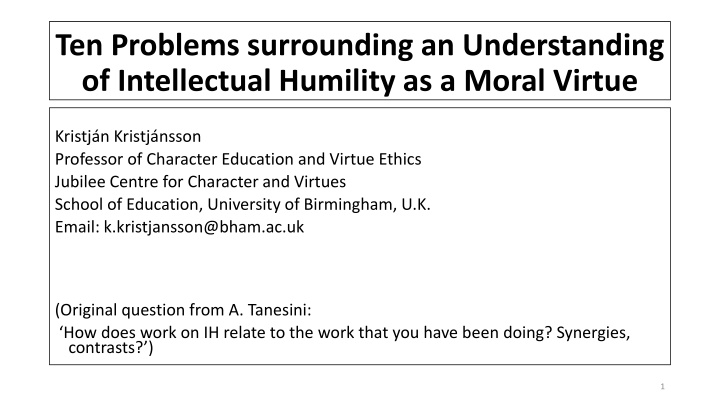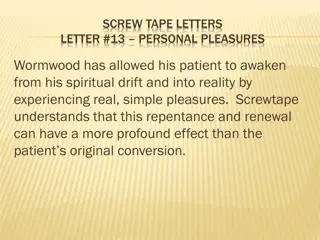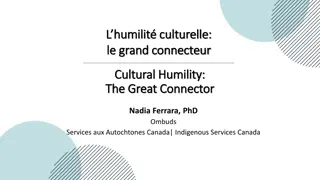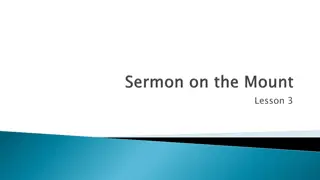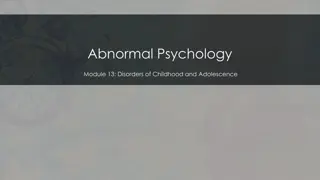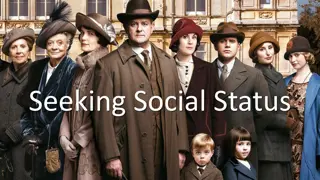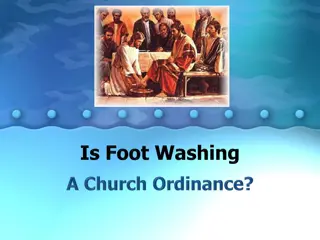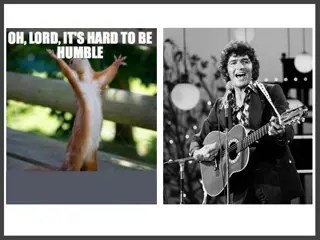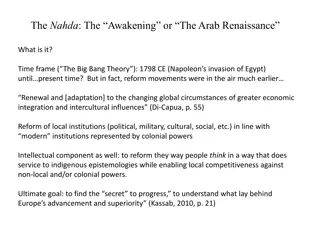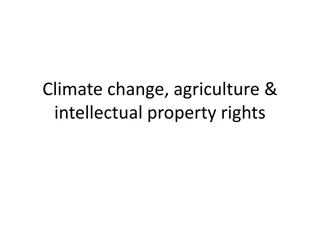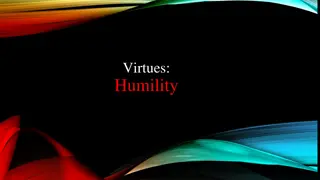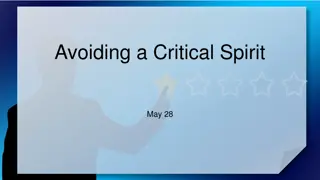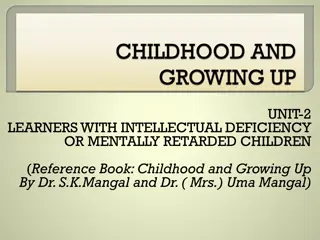Challenges in Understanding Intellectual Humility
Diving into the complexities of intellectual humility as a moral virtue reveals interconnected issues spanning theoretical and practical realms, challenging conventional wisdom on virtue ethics.
Download Presentation

Please find below an Image/Link to download the presentation.
The content on the website is provided AS IS for your information and personal use only. It may not be sold, licensed, or shared on other websites without obtaining consent from the author.If you encounter any issues during the download, it is possible that the publisher has removed the file from their server.
You are allowed to download the files provided on this website for personal or commercial use, subject to the condition that they are used lawfully. All files are the property of their respective owners.
The content on the website is provided AS IS for your information and personal use only. It may not be sold, licensed, or shared on other websites without obtaining consent from the author.
E N D
Presentation Transcript
Ten Problems surrounding an Understanding of Intellectual Humility as a Moral Virtue Kristj n Kristj nsson Professor of Character Education and Virtue Ethics Jubilee Centre for Character and Virtues School of Education, University of Birmingham, U.K. Email: k.kristjansson@bham.ac.uk (Original question from A. Tanesini: How does work on IH relate to the work that you have been doing? Synergies, contrasts? ) 1
Intellectual versus Moral Virtue I There are mountains of literature on intellectual humility (IH) understood (implicitly or explicitly) as an intellectual/epistemic virtue (I use these two synonymously) although no shared understanding of its conceptual contours (Ballantyne, 2023) Do not pretend to have much to add this mountain, esp. when considering the comprehensive critical surveys by Ballantyne (2023) and Porter et al. (2022) I will follow those who see intellectual humility as a subdomain of the virtue of general humility even if it means piggybacking on discourses about the latter (Ballantyne, 2023, p. 202) and, more specifically, I will in what follows understand intellectual humility, like general humility, as a moral virtue 2
Roadmap Not chickening out of a devilishly complex discourse to enter a smoother terrain. Rather go from the frying pan into the fire, because understanding IH as a moral virtue comes with a host of problems of its own. I say surrounding rather than about because many of those problems are not so much about IH specifically as about some of the broader conceptual terrain of moral virtue I will explore 4 general/theoretical problems, 4 problems having to specifically with the presumed individualised golden-mean architectonic of IH and 2 practical problems But a few more clarifications first 3
Intellectual versus Moral Virtue II Zagzebski (1996): Any intellectual virtue is also a moral virtue. Thus, an intellectual virtue does not differ from certain moral virtues any more than one moral virtue differs from another, that the processes related to the two kinds of virtue do not function independently, and that it greatly distorts the nature of both to attempt to analyze them in separate branches of philosophy . See also Carr (2014) on the impossibility of separating moral elements from intellectual ones in intellectual honesty However, overlap is not the same as equivalence, and I do think it is possible to separate the motivation and focus of intellectual virtue from that of a moral virtue, although the same word (e.g. honesty ) can be used to name both 4
Intellectual versus Moral Virtue III My basic understanding of the difference (cf. Porter et al., 2022): Intellectual virtue is a multi-componential, cross-situational character disposition motivated by an intrinsic concern with epistemic goods and aimed at epistemic targets such as truth, accuracy, credibility, plausibility Moral virtue is a multi-componential, cross-situational character disposition motivated by an intrinsic concern with moral goods and aimed at moral targets such as human flourishing, harmonious social interaction, characterological development Also, in contrast to intellectual virtue, moral virtue has a medial form between excess and deficiency (pro Aristotle, 1985; Curzer, 1996 contra Hursthouse, 1980-81) 5
Intellectual versus Moral Virtue IV Many definitions of IH avoid virtue talk altogether, and just refer to a mindset , attitude , or even personality trait (Ballantyne, 2023, p. 200 the last is a bit odd?) However, on closer look, the definitions tend to be closer to or even coincide with that of intellectual virtue : Tanesini, 2018: IH a cluster of strong attitudes and such a cluster can denote an intellectual virtue. IH is not a medial form between extremes (p. 418); and hence not a moral virtue Ballantyne, 2023, more explicit: characterising IH as a socially-oriented mindset a mistake . Even if IH has salient social consequences , should not be confused with the essential features of IH itself (p. 204) 6
Intellectual versus Moral Virtue V Ballantyne can be interpreted as saying: IH is exclusively an intellectual virtue, not a moral virtue Essentially IH denotes an intellectual virtue. However, there could be a less common/salient incarnation of it as a moral virtue B. probably means the former but for the sake of the present argument, I will assume and adopt the latter understanding I have no doubt about the value and existence of an intellectual virtue of IH and am happy to acknowledge it as essential . However, there is also a moral-virtue understanding of IH in ordinary and academic discourse. I am not the first person to hint at this (Porter et al., 2022, p. 582), but be aware that I am still developing a minority view here (exploring a side-stream ) 7
My Def. of IH as a Moral Virtue IH is the morally appropriate (i.e., medial) approach to one s own perceived quality of one s intellectual pursuits. Closest to Gregg & Mahadevan, 2014, p. 8: realistic evaluation of one s epistemic qualities . But mine is a) a moral, not just an epistemic evaluation, b) is both about morally appropriate (here: neither inflated not deflated) perception (as the extremes signify a moral as well as an epistemic failure) and morally appropriate approach to that perception. (Related to, although not the same as, Tanesini s, 2018, two components: self-acceptance and modesty inner and outer manifestations) In taxonomies of IH accounts, this falls into the realistic self-assessment rather than the low self-concern camp (Ballantyne, 2023, p. 201). This distinction mirrors the difference in general humility accounts between systematic non-overestimation of self-worth and systematic underestimation of self-worth, opting for the former (cf. Ben-Ze ev, 1993, p. 240; Nuyen, 1998, p. 101) 8
General Problem 1: Terminological Echoes a well-known problem about general humility: IH on my understanding is a medial disposition between intellectual arrogance/vanity and intellectual self-abasement/pusillanimity (i.e. 2 flanking vices) Problem: In ordinary language, humility is closer to the deficiency form, sounds like an apt translation of Aristotle s mikropsychia (pusillanimity) as a vice of deficiency, i.e. common sense closer to underestimation accounts. Also relates to Christian humility as a monkish virtue of systematic under-estimation of oneself (in light of one s inferiority to God) Solution 1: Replace humility with modesty . But imports another problem, namely that modesty is public-facing (Sinha, 2012, p. 265). Intellectual modesty is compatible with private over-estimation Solution 2: Simply give a stipulative definition like I did and not care about OL. But still unfortunate that the virtue name seems to point towards the deficiency form, and thus turn excess and deficiency around from Aristotle s schema of arrogance (excess), megalopsychia (the medial form), mikropsychia(deficiency). The excess of IH is not arrogance but intellectual mikropsychia!!! 9
General Problem 2: Golden Mean Issues Disposition to actions/emotions exhibited/felt at the right times, about the right things, towards the right people, for the right end, and in the right way (Aristotle, 1985, p. 44 [1106b20-24]) Many variables have to be collated: occasions, objects, motives, people, degree (Curzer, 2023, 198). But some are quantitative (e.g., how many times you mention your intellectual accomplishments), some qualitative (how you talk about them) Hursthouse impossible to calculate: absurd doctrine, esp. the counting part (1980-81). Plus, by analysing the variables into centri-and-deci components, Curzer ends up with 4000 possible failure modes for a complex virtue like courage (2023, p. 198). Sounds like a reductio although Curzer thinks of this as an advantage (educationally at least). Aristotle: one can be bad in all sorts of ways , noble in only one way (ibid., 1106b32-36) 10
General Problem 2: Continued Best arguments for retaining the golden mean come from psychologists, arguing against pos. psych., which has no golden mean ( the more of each virtue is the better ): Leads to: psychological abuses e.g. Stockholm syndrome as the ideal form of gratitude! (Grant & Schwartz, 2011) logical paradoxes (Ng & Tay, 2020) educational misapplications (Morgan et.al., 2015) Solution: Not insurmountable calculation problems if we have clear paradigmatic cases and can simply adjust from those: Compared to the paradigmatic case of virtue x, A showed a bit too little/much 11
General Problem 3: Lack of Paradigmatic Cases We generally solve Problem 2 by identifying a paradigmatic case of the virtue being shown medially: the brave soldier or cancer patient, the compassionate nurse or relief worker. We then make subtle contextual and individualised adjustments to judge the fittingness of a person s actions/emotions to the paradigmatic golden-mean cases Those cases also yield moral exemplars to admire and emulate: the brave Martin Luther King, the compassionate Florence Nightingale, etc. (Aristotle is clever at giving us plausible paradigmatic examples for individual virtues, except in the case of megalopsychia, where the paradigmatic cases puzzle us in many ways) 12
General Problem 3 Continued The problem is that such cases/exemplars are not forthcoming in the case of IH. Many cases of people admired for their intellectual acumen in spite of not being intellectually humble: Philosophy Nietzsche Painting Dal Poetry - Frost Physics Hawking Not so much that we admire them intellectually despite their lack of IH; the lack of IH is part of the appeal (e.g., Dal , Nietzsche). The intellectual sphere does not seem to be a fertile ground for humility, nor humility help define acting well or badly in a discrete sphere of human experience (Nussbaum, 1988) If the lack of a moral virtue is not seen as flourishing-reducing in salient cases, we may wonder whether it is a real virtue Solution: We probably need to think of more paradigmatic cases of generally humble persons (e.g. humble sportsmen like Bobby Charlton) and then transfer those to the intellectual sphere. But also obvious counter-examples in sport, like M. Ali 13
General Problem 4: Variance in the Mean For some virtues, the aimed-for medial state is not exactly in the middle between excess and deficiency but closer to one extreme. This is very important educationally because in character ed., we try to drag students away from the extreme that they are closer to, like they do in straitening bent wood (Aristotle,1985, pp. 51-52 [1109a30-b8]) Aristotle gives 2 examples: the mean of mildness of temper is closer to meekness than irascibility because people are more prone to unjustified anger; generosity is closer to wastefulness than niggardliness because most people are too stingy in giving. No such observations about proper self-worth, but the mean may seem closer to arrogance than pusillanimity because the people hitting the relative mean (the megalopsychoi) are not exactly lacking in self-confidence! Solution: So is too much IH more of a problem than too little? An empirical question (according to Aristotle s naturalistic methodology) that needs to ground educational interventions 14
Preamble to Problems 5-8: About contextualisation and individualisation The mean is not in the object , but relative to us . Temperance in eating is not the same for Milo the athlete and the novice athlete. Not a mere numerical calculation like 6 between 2 and 10. So the mean is not the same for everyone (Aristotle, 1985, p. 43 [1106a30-b8]) Relative to us can refer to various kinds of individual and contextual variance: 5) personal constitution, 6) developmental level, 7) social role, 8) cultural variance All this variance complicates identification of the golden mean of a virtue like IH (and perhaps more than many other virtues because of Problem 3 and a lack of empirical evidence about Problem 4) 15
Relativity Problem 5: Personal Constitution The Greeks had no term for personality traits on modern understanding as distinct from character traits . But given what we know about the Big-Five, it is plausible to hypothesise that IH (as a virtue) will manifest itself differently for the introvert than for the extravert. Other personality traits may also matter in evaluations of individual IH, e.g. openness and remember that many of those traits are more or less constant (genetic), as opposed to ch. traits (e.g. virtues) An extreme case: Persons on the autistic spectrum. Because of their limited emotional repertoire and EQ, we may even wonder whether it is fair to evaluate them at all with Aristotelian virtue constructs (Dineen, 2019) Solution: We need to know quite a lot about personal constitution before ascribing IH to a person 16
Relativity Problem 6: Developmental Level Some virtues are only virtues for people at certain developmental levels, such as emulation for the young. Even for virtues that apply to all ages, how we identify them and evaluate them depends on the person s characterological/developmental level Extra problem: Complex interactions between Problems 5 and 6. Example: My own diatribe against postmodernism 25 years ago: 10 articles in a lit. journal that, if written by me today, would count as lacking in IH (arrogant, cynical, dismissive, acrimonious) Two interpretations: a) Written when my testosterone levels where much higher, hence IH at that time (see 5). b) Even less IH then than now because I was less developed then as an academic and should have been even more humble (see 6) Solution: IH theorists need to be well versed in developmental psychology! 17
Relativity Problem 7: Social Roles Aristotle talks a lot about role-dependent virtues, giving examples of statespersons, doctors, craftsmen, etc. Some virtues are exclusively dependent on certain social roles and resources (such as magnificence in giving). Lack of magnificence in a poor person is not a vice Examples: An academic who goes into politics will have a greater warrant for boosterism than she had at academic conferences Even within academia, there may be different criteria for IH in different disciplines, e.g. what counts as IH at a philosophy conference may be seen as arrogance at a psychology conference Solution: An appraisal of the social context is crucial for the correct identification of IH 18
Relativity Problem 8: Cultural Variance Aristotle was keenly aware in the Politics of such variance regarding political/civic virtues, e.g. justice as a civic virtue being relative to constitutions . However, fairly na ve universalism about moral/characterological virtues in the NE: In our travels we see how similar human beings are (morally): Aristotle, 1985, p. 208 [1155a20- 22]). He simply had no interest in or knowledge of remote cultures Given what we know today, e.g. about the difference between independent and interdependent cultures (Markus & Kitayama, 1991), we need to assess IH differently in, say, Japan and USA (Grossmann et al., 2020) Solution: We need a multiculturally sensitive account of IH! 19
Practical Problem 9: Educating the Moral Virtue of IH Not a discrete problem, but an implication of Problems 3-8. A boxing instructor does not impose the same way of fighting on everyone (Aristotle, 1985, p. 295 [1180b9-11]) Without the recourse to paradigmatic cases and widely acknowledged moral exemplars, the original baseline is not clear enough (Problem 3) Without knowing where the mean of the virtue lies in general, we cannot apply the straitening-bent-wood principle (Problem 4) Without knowing about the individualised variables (Problems 5-8), we cannot educate the individual student well in IH Solution: Problems 5-8 are much the same as for other virtues in ch.ed., but Problems 3 and 4 make this task even harder. We need a great amount of empirical/psychological research and measurements of numerous variables 20
Practical Problem 10: Measuring IH as a Moral Virtue A lot has been written about measurements of IH, but mostly when understood as an intellectual virtue (Porter et al., 2022) If we want to understand IH as a moral virtue (also), other general considerations apply of how to measure multi-componential psycho-moral constructs (Wright et al., 2021; Kristj nsson & Fowers, 2024; Fowers et al., 2024) Most important tasks: Explore the relationship between flourishing and IH, and between phronesis and IH, because flourishing and phronesis are the key constructs in neo-Aristotelian virtue ethics/ch.ed. Extensive theoretical discourse and empirical studies about IH and general wisdom already (Grossmann et al., 2020), but very little so far about phronesis and IH, or flourishing (e.g. as understood in VanderWeele s 2017 much-used model) and IH (A final note about modesty ) 21
References Aristotle (1985). Nicomachean ethics, trans. T. Irwin. Hackett Publishing. Ballantyne, N. (2023). Recent work on intellectual humility: A philosopher s perspective. Journal of Positive Psychology, 18(2), 200-220. Ben-Ze ev, A. (1993). The virtue of modesty. American Philosophical Quarterly, 30(3), 235 246. Carr, D. (2014). The human and educational significance of honesty as an epistemic and moral virtue. Educational Theory, 64(1), 1-15. Curzer, H. J. (1996). A defense of Aristotle s doctrine that virtue is a mean. Ancient Philosophy, 16(1), 129-138. Curzer, H. J. (2023). Virtue ethics for the real world: Improving character without idealization. Routledge. Dineen, K. (2019). Kant, emotion and autism: Towards an inclusive approach to character education. Ethics and Education, 14(1), 1-14. Fowers, B. J., Cokelet, B., & Leonhardt, N. D. (2024). The science of virtue: A framework for research. Cambridge University Press. Grant, A. M., & Schwartz, B. (2011). Too much of a good thing: The challenge and opportunity of the inverted U. Perspectives on Psychological Science, 6(1), 61-76. Gregg, A. P., & Mahadevan, N. (2014). Intellectual arrogance and intellectual humility: An evolutionary epistemological account. Journal of Psychology and Theology, 42(1), 7-18. Grossmann, I., Weststrate, N. M., Ardelt, M., Brienza, J. P., Dong, M., Ferrari, M., Fournier, M. A., Hu, C. S., Nusbaum, H. C., & Vervaeke, J. (2020). The science of wisdom in a polarized world: Knowns and unknowns. Psychological Inquiry, 31(2), 103-133. Hursthouse, R. (1980-81). A false doctrine of the mean. Proceedings of the Aristotelian Society, 81(1), 57-72. Kristj nsson, K., & Fowers, B. J. (2024). Phronesis: Retrieving practical wisdom in psychology, philosophy, and education. Oxford University Press. 22
References - continued Markus, H. R., & Kitayama, S. (1991). Culture and self: Implications for cognition, emotion, and motivation. Psychological Review, 98(2), 224-253. Morgan, B., Gulliford, L., & Carr, D. (2015). Educating gratitude: Some conceptual and moral misgivings. Journal of Moral Education, 44(1), 97-111. Ng, V., & Tay, L. (2020). Lost in translation: The construct representation of character virtues. Perspectives on Psychological Science, 15(2), 300-326. Nussbaum, M. C. (1988). Non-relative virtues: An Aristotelian approach. Midwest Studies in Philosophy, 13(1), 32-53. Nuyen, A. T. (1998). Just modesty. American Philosophical Quarterly, 35(1), 101-109. Porter, T., Baldwin, C. B., Warren, M. T., Murray, E. D., Bronk, K. C., Forgeard, M. J. C., Snow, N. E., & Jayawickreme, E. (2022). Clarifying the content of intellectual humility: A systematic review and integrative framework. Journal of Personality Assessment, 104(5), 573-585. Sinha, A. (2012). Modernizing the virtue of humility. Australasian Journal of Philosophy, 90(2), 259 274. Tanesini, A. (2018). Intellectual humility as attitude. Philosophy and Phenomenological Research, 96(2), 399-420. VanderWeele, T. J. (2017). On the promotion of human flourishing. Proceedings of the National Academy of Sciences, 114(31), 8148 8156. Wright, J., Warren, M., & Snow, N. (2021). Understanding virtue: Theory and measurement. Oxford University Press. Zagzebski, L. (1996). Virtues of the mind. Cambridge University Press. 23
